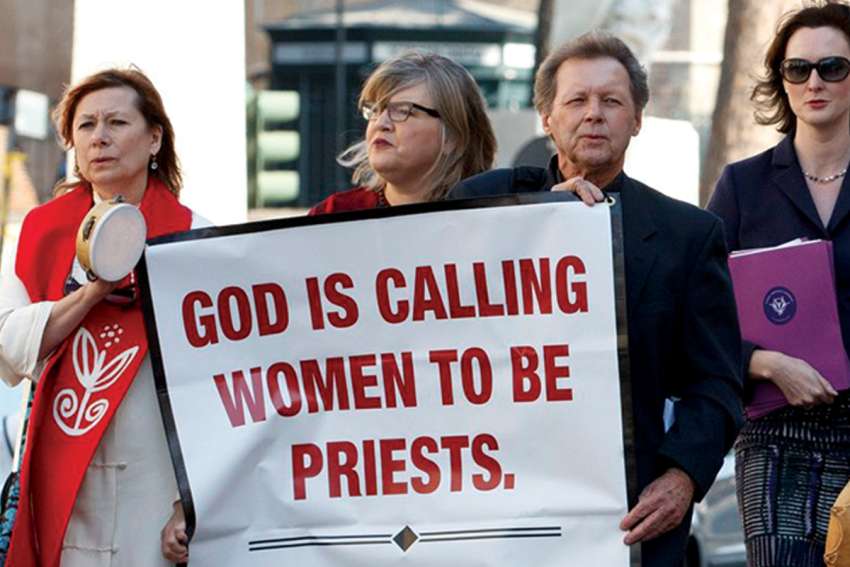It’s clear the ordained, ministerial priesthood is male-only, but what about deacons? Paul’s use of “deacon” to refer to Phoebe was not the same “diaconate” as the first male deacons (Acts 6:1-7), “The Seven,” chosen by the Twelve Apostles. Nor is it equivalent to the restored (1967) male permanent diaconate.
Some thought there were female deacons in the early Church for the purpose of attending to newly baptized females. Baptism then Church was understood as a radical life-change. Candidates were baptized naked, by full immersion. Further research has discovered these women-helpers had a different title.
There are three degrees of Holy Orders: deacon (diaconate), priest (priesthood) and bishop (episcopacy). Permanent deacons (and priests) are “a proper and permanent rank of the hierarchy” (the Church’s governance of souls), and are considered clerics/clergy. Since Holy Orders is “reserved” for baptized males whose vocation is approved by Holy Mother Church, and the diaconate is included in Holy Orders, only a man can be a deacon.
Why is ordination the provenance of men? An understanding of the former “minor orders” in the Church can shed light on the matter. Minor orders date back to at least the third century and were abolished as “orders” by Pope Paul VI in 1972. The terminology for the first four minor orders is now “ministries,” and the sub-diaconate no longer exists. The minor orders were: porter, reader, exorcist, acolyte, sub-deacon. The clergy and Catholic Christian community as a whole used to actively call forth eligible young males to these “starter” roles from which some pursue the priesthood. (St. Joseph’s Seminary in Edmonton transferred the beautiful stained glass windows depicting minor orders from the old seminary chapel to the new seminary chapel.)
What did these positions entail? “Porter” (security, a parish bouncer: Pakistan’s first Servant of God is Akash Bashir, a young man martyred when he stopped a suicide bomber from entering a packed church in 2015); “reader” (lector); “exorcist” (with a small “e,” meaning the young man could pray deliverance prayers with people stopping by the church); “acolyte” (altar server); “sub-deacon” (sacristan, in charge of altar servers, assisted in certain parts of the Mass in the sanctuary). Whatever pertains directly to the actions of the Sacred Liturgy is performed by the Bridegroom’s “groomsmen,” as it were.
Only men can be ordained, but Phoebe and other women were most likely consecrated for other needed assignments. The Ethiopian Orthodox Church continues this or a similar tradition by consecrating women “deaconesses.” Cardinal Gerhard Müller, former head of the Congregation for the Doctrine of the Faith, noted it would be “anachronistic” and needless for the Catholic Church to revive this role from prior times when today women serve the Church in innumerable ways. There are more women in key positions at the Vatican, national, diocesan and local levels of the Church than most Fortune 500 companies and the world’s governments.
There are two different ways to be a body-person, two different ways to be in the image of God (male and female), and although we both share in a single human nature and are equal in dignity, we are not identical.
The essence of maleness and femaleness matters. Pope John Paul II called our physical and spiritual manhood and womanhood “a fundamental component of human existence,” that is expressed and lived out in different ways, above all in the family (the domestic Church) and in the service and worship of God.
The ordained ministry is not simply a function that anyone with the aptitude can carry out, because it’s not first about doing but being. We need to be grounded in the basics of “an adequate anthropology,” Christology, Mariology and Ecclesiology in order to comprehend God’s plan and God’s will in the divine order. The study of Christ, Mary and the Church are inseparable and shed light on who we are as women and men — unique members of Jesus’ Mystical Body.
(Sr. Helena Raphael Burns, fsp, is a Daughter of St. Paul. She holds a Masters in Media Literacy Education and studied screenwriting at UCLA. HellBurns.com Twitter: @srhelenaburns #medianuns)

